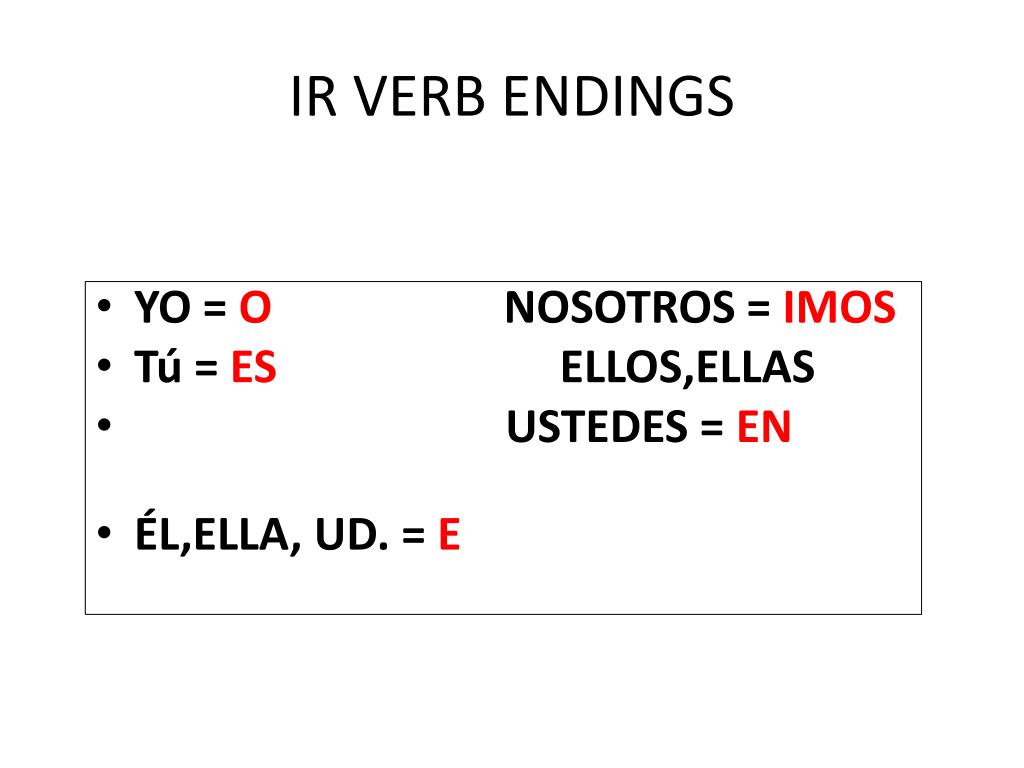


Si nosotros fuéramos a Nueva York, te diríamos. If you went to the bank earlier it would be better. Si tú fueras al banco temprano sería mejor. Lo que quiero es que nos vayamos temprano. The fact that I go to the beach doesn’t change anything. The latter one is rarely used, so I did not include it in this lesson.Įl que yo vaya a la playa no cambia nada. The forms of this mood are the present, past, past perfect, and future subjunctive. This is a more advanced mode of the Spanish verb ir. We use the subjunctive mood to talk about hypotheses, hopes, wishes, or uncertainty. They would go to class but they closed the school. You would go on holiday if you wanted to.Įllos irían a clase pero cerraron la escuela. In the conditional form of the verb ir, the stem stays the same and it translates to English as “would go”. In the future tense, the stem stays the same and every conjugation starts with ir-, they all translate to “will go.” Yo You used to go to the north stadium, now to the south. Tú ibas al estadio norte, ahora al del sur. The past imperfect form -that once again, has a stem change from ir to iba– is translated to “used to.” Yo In the past tense, ir conjugation has another stem change from ir to fui– and fue. The stem change is complete from ir to vo- and va. The present tense of the ir verb is the most common one. By learning the present simple, past simple, future simple, past imperfect, and conditional you will understand basic expressions and conversation with ir. The indicative mood has the most basic tenses of the Spanish verb ir. The conjugation changes in these tenses happen in the helping verb, while the form of ir stays the same. These compound tenses involve using the helping verbs haber and estar.
IR VERB ENDINGS PDF
You also need to know that this post is designed so you can study it in bite sizes and with a downloadable and printable PDF with charts.įor these ir conjugations, there are two forms of ir that you need to learn. If you are not familiar with the tenses of the highly irregular ir conjugation, don’t worry! I’ve got your back! I am breaking down every single one for you with explanations and examples. Let’s get going! The Ultimate Guide to Ir Conjugation

IR VERB ENDINGS HOW TO
Also, I am giving you useful information about bilingualism and how to learn Spanish faster. What do you think of the expression me voy a ir yendo? It is a grammatically correct sentence that uses three different tenses of the ir conjugation to mean “I will get going.” Read ahead to find every tense of the ir conjugation and more expressions like this!Īt the end of the blog post, there is a multiple-choice quiz so you can test your newly acquired knowledge.

Today, we’ll learn this ending ir conjugation in multiple forms, encompassing three moods: Some less-common translations are “to head,” “to leave,” “to pass by,” “to chase after,” “to pursue,” and “to run away.” Just as in English it does not always mean going somewhere physically, but also mentally, emotionally, and when you are “going to do something.” Ir is an irregular and stem-changing verb that means “to go.” It is part of the – ir verbs in Spanish such as decir, seguir, venir and salir. Ir is one of the most used verbs in Spanish, so get ready to level up your language understanding. We’re going to learn-or vamos a aprender-about the conjugation of the verb ir in Spanish!
IR VERB ENDINGS FREE
Jby Nicole Canún Spanish Grammar 4 comments Ir Conjugation: Free Spanish Lesson, Quiz, and PDF


 0 kommentar(er)
0 kommentar(er)
